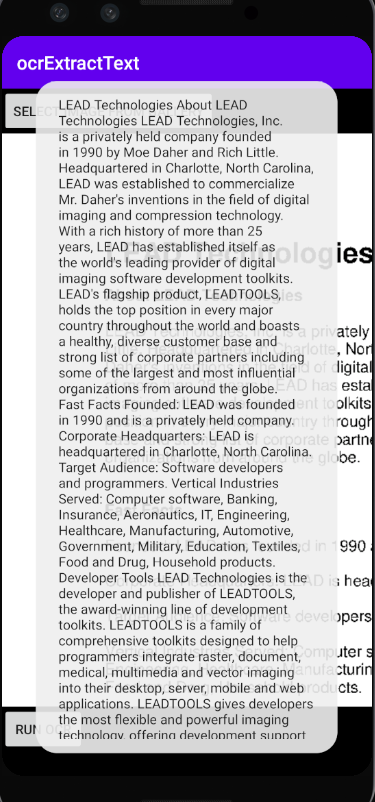Recognize Text from Images with OCR - Android Java
This tutorial shows how to recognize text from an image in an Android Java application using the LEADTOOLS SDK.
| Overview | |
|---|---|
| Summary | This tutorial covers how to extract text from an image in an Android Java application. |
| Completion Time | 20 minutes |
| Android Studio Project | Download tutorial project (104 KB) |
| Platform | Android (Java) |
| IDE | Android Studio |
| Runtime License | Download LEADTOOLS |
Required Knowledge
Get familiar with the basic steps of creating a project by reviewing the Add References and Set a License and Android - Get Started with Maven tutorials, before working on the Recognize Text from Images with OCR - Android Java tutorial.
Create the Project and add the Maven artifacts
In Android Studio, create a new Android (Java) project, and add the Artifacts.
Set the License File
The License unlocks the features needed for the project. It must be set before any toolkit function is called. For details, including tutorials for different platforms, refer to Setting a Runtime License.
There are two types of runtime licenses:
- Evaluation license, obtained at the time the evaluation toolkit is downloaded. It allows the toolkit to be evaluated.
- Deployment license. If a Deployment license file and developer key are required, refer to Obtaining a License.
Note
Adding LEADTOOLS local references and setting a license are covered in more detail in the Add References and Set a License tutorial.
Set the Application Layout
In the Project Explorer window, open the activity_main.xml file found in the app/src/main/res/layout directory. Below the RasterImageViewer XML code add a new RUN OCR button.
<LinearLayout xmlns:android="http://schemas.android.com/apk/res/android"android:layout_width="match_parent"android:layout_height="match_parent"android:orientation="vertical"android:weightSum="1.0"android:background="@android:color/black"><Buttonandroid:layout_width="wrap_content"android:layout_height="wrap_content"android:text="Select Image From Gallery"android:onClick="onSelectImage"/><leadtools.controls.RasterImageViewerandroid:id="@+id/rasterimageviewer"android:layout_width="match_parent"android:layout_height="0dp"android:layout_weight=".96"android:background="@android:color/white"/><Buttonandroid:id="@+id/button"android:layout_width="wrap_content"android:layout_height="wrap_content"android:text="Run OCR"android:onClick="ocr"/></LinearLayout>
Add the Extract Text Code
In MainActivity.java, add the following import statements before the MainActivity class:
import leadtools.ocr.OcrEngine;import leadtools.ocr.OcrEngineManager;import leadtools.ocr.OcrEngineType;import leadtools.ocr.OcrImageSharingMode;import leadtools.ocr.OcrPage;import leadtools.ocr.OcrPageCharacters;import leadtools.ocr.OcrWord;import leadtools.ocr.OcrZoneCharacters;
Add the following member variables to the MainActivity class:
private OcrEngine ocrEngine;private StringBuilder sb;
Update the onCreate() function as shown below:
@Overrideprotected void onCreate(Bundle savedInstanceState) {super.onCreate(savedInstanceState);setContentView(R.layout.activity_main);// Load LEADTOOLS native librariestry{Platform.setLibPath(sharedLibsPath);Platform.loadLibrary(LTLibrary.LEADTOOLS);Platform.loadLibrary(LTLibrary.CODECS);Platform.loadLibrary(LTLibrary.OCR);}catch(Exception ex) {Log.d(TAG,"Failed to load LEADTOOLS Native libraries" );}sb = new StringBuilder();String demoBaseDir = getFilesDir().toString();if (!demoBaseDir.endsWith("/"))demoBaseDir += "/";String ocrLanguageFileDir = demoBaseDir + "/OCRRuntime/";String substitutionFontsDir = demoBaseDir + "/SubstitutionFonts/";if (!Utils.copyOcrRuntimeFiles(this, ocrLanguageFileDir)) {Log.d(TAG, "Failed to copy OCR Language Files");finish();}if (!Utils.copyAssetsFiles(this, "substitution_fonts", substitutionFontsDir)) {Log.d(TAG, "Failed to copy Substitution Fonts");finish();}try {//Set Substitution Fonts path and startup the OCR EngineRasterDefaults.setResourceDirectory(LEADResourceDirectory.FONTS, substitutionFontsDir);ocrEngine = OcrEngineManager.createEngine(OcrEngineType.LEAD);ocrEngine.startup(null, null, null, ocrLanguageFileDir);} catch (Exception e) {Toast.makeText(this, e.getMessage(), Toast.LENGTH_LONG).show();}if (!ocrEngine.isStarted()) {Toast.makeText(this, "OCR Engine was not started successfully", Toast.LENGTH_LONG).show();}}
Create a ocr(View v) function to allow the parsing of files. Add the below code:
public void ocr(View v ){RasterImage image = mViewer.getImage();if(image != null){OcrPage ocrPage = ocrEngine.createPage(image, OcrImageSharingMode.AUTO_DISPOSE);ocrPage.recognize(null);OcrPageCharacters ocrpageCharacters = ocrPage.getRecognizedCharacters();for (OcrZoneCharacters ocrzonechar: ocrpageCharacters){Collection<OcrWord> words = ocrzonechar.getWords();for (OcrWord word: words){sb.append(word.getValue());sb.append(" ");}}Toast.makeText(this, sb.toString(), Toast.LENGTH_LONG).show();}else{Toast.makeText(this, "No File is loaded", Toast.LENGTH_LONG).show();}}
Run the Project
Press Shift + F10 to run the application. Follow the steps below to test the application.
- On the device, select the
SELECT IMAGE FROM GALLERYto load in an image. -
Select the
RUN OCRbutton to read the image and output the results.
Wrap-up
This tutorial showed how to run OCR recognition on an image.
